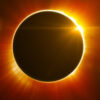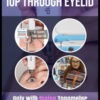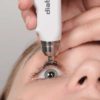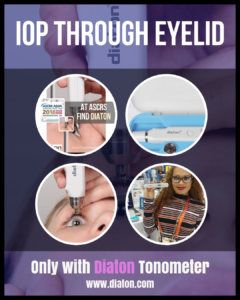Diaton Transpalpebral and Non-corneal tonometer presented at Optometry's Meeting AOA, in Philadelphia
Through the eyelid tonometer Diaton was featured at the Optometry's Meeting in Philadelphia. Diaton allows quick and painless measurements of intraocular pressure independent of corneal properties.

Recent clinical study Comparing of Accuracy of Diaton Transpalpebral Tonometer Versus Goldmann Applanation Tonometer, Dynamic Contour Tonometer and Ocular Response Analyzer show the following results:
Henry D Perry, MD, Valeriy Erichev, MD PhD; E S Avetisov MD; Alla Illarionova, MD,Alexey Antonov MD;
PURPOSE:
To compare intraocular pressure measurements obtained with the diaton transpalpebral tonometer with those from ocular response analyzer (ORA), dynamic (should be in same order as title) contour tonometry (DCT) and Goldmann applanation tonometry (GAT) inpatients diagnosed with primary open-angle glaucoma (POAG) and glaucoma suspects, and to determine the effects of central corneal thickness (CCT) and corneal hysteresis (CH) on intraocular pressure (IOP) measurements with these devices.
METHODS:
40 patients (80 eyes) age 42-83 years with POAG and glaucoma suspects wereincluded in the study. The average of ORA (corneal compensated IOP [IOP-ORAcc] and Goldmann-correlated IOP [IOP-ORAg]), DCT, GAT, and Diaton tonometer levels werecompared and the devices were examined with respect to CCT and CH. Spearman's correlation tests were used for statistical analysis.
RESULTS:
Mean CCT was 561,2±32,4mum and mean CH was 10.6+/-2.0 mmHg. Mean IOP obtained using DCT was 18,9±4,1 mmHg, whereas those provided by ORA were 18,2±3,4mmHg for IOP-ORAcc and 18,4±3,5 mmHg for IOP-ORAg. The mean IOP obtained using GATand Diaton were 18,4±4,1 mmHg and 17,0±3,0 mmHg respectively.The performed analysis of correlation between IOP meanings shows high conformity of results of Diaton with IOP-ORAcc and DCT. The differences between the measurements of DCT, ORAand Diaton were statistically significant. Correlated rates relations: between IOP-ORAcc andDCT 0,89; between IOP-ORAcc and Diaton 0,96; IOP-ORAcc and GAT 0,56; between GATand Diaton 0,61; GAT and DCT 0,73; DCT and Diaton 0,87.
CONCLUSIONS:
Transpalpebral Tonometry is an accurate method of IOP measurement that is also independent from the biomechanical characteristics of cornea.It can be recommended for IOP measurements of patients diagnosed with glaucoma including those cases where cornea pathology or cornea characteristics have been altered.
Diaton was very well received at the meeting with many Optometry School professors looking forward of adding this tonometer to the OD curriculum.
Diaton tonometer is a perfect device for mass screenings for glaucoma for any age group. Undiagnosed and untreated, glaucoma can cause blindness. Glaucoma is the leading cause of blindness in all age groups – from babies to senior citizens. Everyone needs to get diagnosed to preserve eyesight.
Diaton tonometer is priced very competitively at only $2,750 USD and it is delivered complete (no need to purchase additional accessories, tips, covers..etc.,), free 2nd Year Warranty, Calibration Tester/ Training Plate (no need for daily calibration), Carry Case, Battery and Training DVD in 5 different languages + phone based training support.
BiCOM Inc. covers the full scope of customer service, which involves client training, follow ups, hotline support, sales support, etc. More information on Diaton tonometer, including clinical trials data and demo video can be found at http://www.TonometerDiaton.com or by calling BiCOM Inc., at the Toll Free number 1-877-diatons (877-342-8667).
Follow Diaton tonometer on: http://www.Facebook.com/tonometer http://www.Pinterest.com/tonometer http://www.Twitter.com/tonometer http://www.LinkedIn.com/company/tonometer







